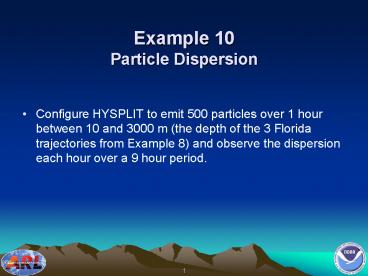Example 10 Particle Dispersion PowerPoint PPT Presentation
Title: Example 10 Particle Dispersion
1
Example 10Particle Dispersion
- Configure HYSPLIT to emit 500 particles over 1
hour between 10 and 3000 m (the depth of the 3
Florida trajectories from Example 8) and observe
the dispersion each hour over a 9 hour period.
2
Run particle dispersion model with NAMF12
forecast data from the Workshop archive.
3
Choose Source Location
Enter a starting location at 28.608N and 80.604W
4
Total run time 9 hours
Source top height 3000 m AGL Source bottom
height 10 m AGL
Number of particles released per cycle 500
(minimum)
Particle dump interval 1 hour
Request Dispersion Run
5
Submit the job and view the results
6
Particle Dispersion Results
When complete, the model results page will
include a link to the animation.
Notice how the particles are moving away from the
source to the east at the higher levels and
toward the southwest at the lower levels, as was
expected based on the 3 trajectories computed
earlier. Also notice how the particles become
few and far between with time (indicating too few
particles).
Use the back button on the browser to rerun the
case with 5000 particles (no rerun option exists
yet).
7
Number of particles released per cycle 5000
Request Dispersion Run
8
Submit the job and view the results
9
Particle Dispersion Results
Running HYSPLIT with 5000 particles shows the
same pattern as before, but with many more
particles helping to define the plume shape. The
red line attempts to create a cross-section
through the bulk of the plume, the result of
which is displayed below the map. Particles are
color-coded based on their position above the
ground.
PowerShow.com is a leading presentation sharing website. It has millions of presentations already uploaded and available with 1,000s more being uploaded by its users every day. Whatever your area of interest, here you’ll be able to find and view presentations you’ll love and possibly download. And, best of all, it is completely free and easy to use.
You might even have a presentation you’d like to share with others. If so, just upload it to PowerShow.com. We’ll convert it to an HTML5 slideshow that includes all the media types you’ve already added: audio, video, music, pictures, animations and transition effects. Then you can share it with your target audience as well as PowerShow.com’s millions of monthly visitors. And, again, it’s all free.
About the Developers
PowerShow.com is brought to you by CrystalGraphics, the award-winning developer and market-leading publisher of rich-media enhancement products for presentations. Our product offerings include millions of PowerPoint templates, diagrams, animated 3D characters and more.

